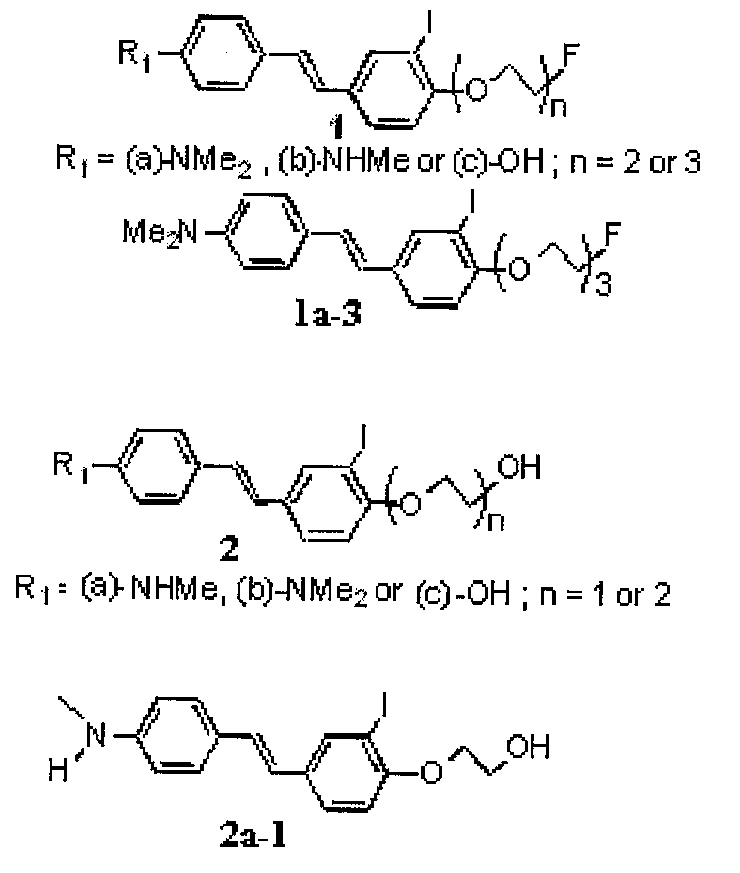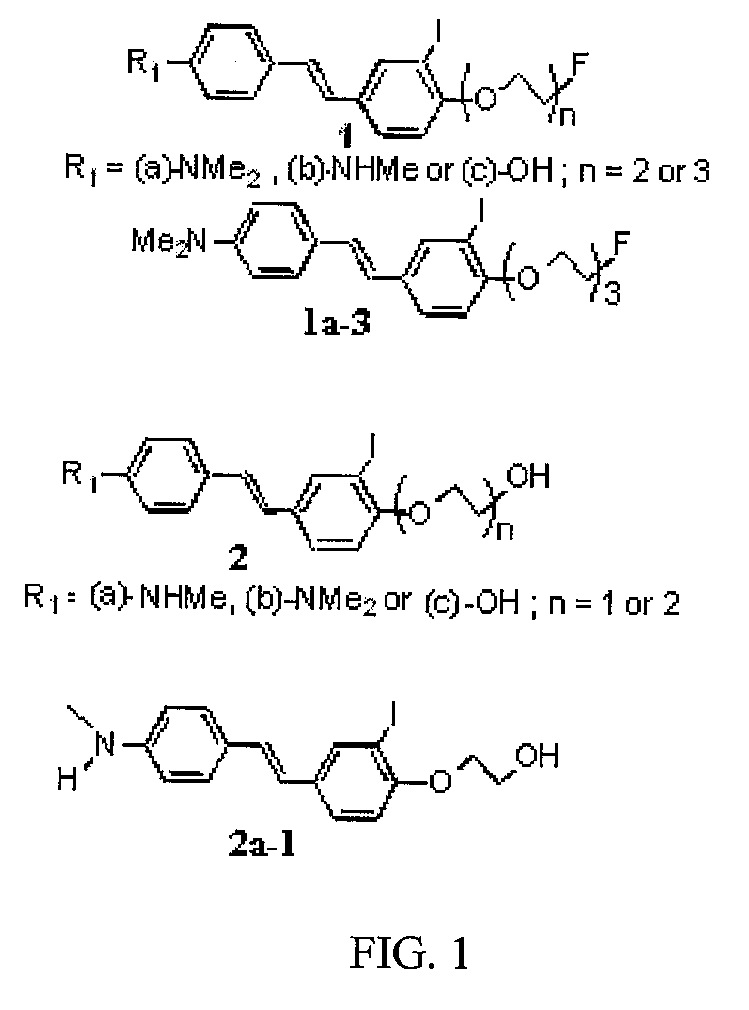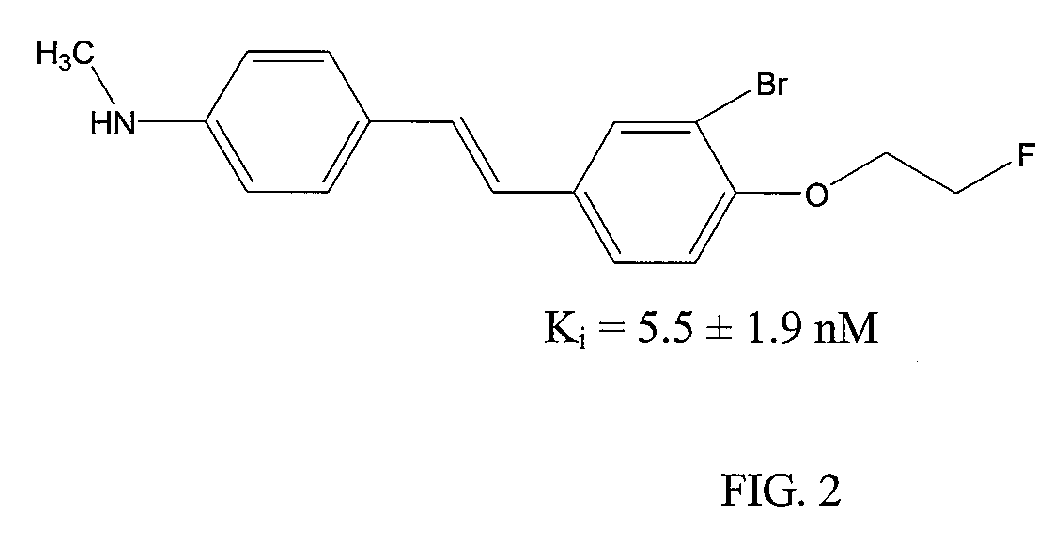Halo-Stilbene Derivatives And Their Use For Binding And Imaging Of Amyloid Plaques
a technology of halo-stilbene and amyloid plaques, which is applied in the field of styrylpyridine compounds, can solve the problems of amyloid deposits being difficult to direct imaging in vivo, and amyloid deposits being difficult to imag
- Summary
- Abstract
- Description
- Claims
- Application Information
AI Technical Summary
Benefits of technology
Problems solved by technology
Method used
Image
Examples
example 1
(E)-2-(3-iodo-5-(4-(methylamino)styrl)phenoxy)ethanol
[0087]123I-15: (E)-2-(2-[123I]iodo-4-(4-(methylamino)styryl)phenoxy)ethanol
[0088]151 (E)-2-(3-iodo-5-(4-(methylamino)styryl)phenoxy)ethanol, cold reference standard for 123I-15
SUMMARY
[0089]
TABLE 1Pharmacological properties of Compound 15Biodistribution inMiceSpecificity(% dose / g in brain)BindingBinding Affinityfor Plaques260Target(Ki, nM)(section labeling)Selectivityminmin15Amyloid Plaque9.4 ± 1.8No high affinity binding to any CNS receptors3.40 ± 0.30.43 ± 0.05
[0090]Compound 15 shows high affinity and specific binding to amyloid plaques, as demonstrated by competitive binding studies using the known amyloid binding agent 125I-IMPY (6-iodo-2-(4′-dimethylamino-)phenyl-imidazo[1,2-a]pyridine). In these experiments Compound 15 showed a Ki of 9.4±1.8 nM, comparable to other experimental amyloid imaging agents. 123I-15, when applied at tracer concentrations, specifically labeled Aβ plaques in sections from patients with pathologically ...
example 2
(E)-4-(2-(6-(2-(2-(2-fluoroethoxy)ethoxy)ethoxy)phenyl)-vinyl)-N-methylbenzamine and (E)-4-(4-(2-(2-(2-fluoroethoxy)ethoxy)ethoxy)-3-iodostyryl)-N-methylbenzenamine
[0103]
SUMMARY
[0104]Compound 1b-3 showed high affinity and specific binding to amyloid plaques, as demonstrated by competitive binding studies using the known amyloid binding agent 125I-IMPY. In those experiments Compound 1b-3 showed a Ki of 9.0±1.8 nM, comparable to Compound 3 and other experimental amyloid imaging agents. 123I-1b-3, when applied at tracer concentrations, specifically labeled Aβ plaques in sections from patients with pathologically confirmed AD.
[0105]In both rodent and primate in vivo experiments 123I-1b-3 showed appropriate biodistribution for a brain imaging agent. When administered i.v. to normal male mice, 123I-1b-3 entered the brain and reached a peak brain concentration of 2.0% dose / g within 2 min and fell to 0.51% dose / g within 60 min. An estimate of human dosimetry, based on extrapolation from the...
example 3
[0113]A compound of the present invention is tested in an established in-vitro immunoblot assay for its ability to inhibit the formation of Aβ oligomers and fibrils (Yang F, Liim G P, Begum A N et al. Curcumin inhibits formation of amyloid β oligomers and fibrils, binds plaques, and reduces amyloid in-vivo. J. Biol. Chem. 280:5892-5901, 2005). Curcumin, a natural molecule serves as positive control. Compounds of this invention are able to inhibit the aggregation Aβ in a manner similar to Curcumin at concentrations of 1-100 μM.
PUM
| Property | Measurement | Unit |
|---|---|---|
| Composition | aaaaa | aaaaa |
| Structure | aaaaa | aaaaa |
| Aggregation | aaaaa | aaaaa |
Abstract
Description
Claims
Application Information
 Login to View More
Login to View More - R&D
- Intellectual Property
- Life Sciences
- Materials
- Tech Scout
- Unparalleled Data Quality
- Higher Quality Content
- 60% Fewer Hallucinations
Browse by: Latest US Patents, China's latest patents, Technical Efficacy Thesaurus, Application Domain, Technology Topic, Popular Technical Reports.
© 2025 PatSnap. All rights reserved.Legal|Privacy policy|Modern Slavery Act Transparency Statement|Sitemap|About US| Contact US: help@patsnap.com



